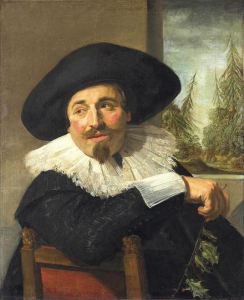Frans Hals, Sometimes called Frans Hals the Elder, was a Painter from the Dutch Golden Age. He was born sometime in 1582 or 1583 in Antwerp, Netherlands, and lived until August 26, 1666. During this time he became popular for his artwork, largely in Portraiture. Copy of self Portrait After Frans Hals [Public domain]
Copy of self Portrait After Frans Hals [Public domain]
Something that distinguishes Frans Hals from other painters of his day was that he was fond of, and is now considered a master of a style that, in his day was considered poor skill or flawed. He deliberately and left his brushstrokes to create depth and texture in his pieces, lending, in his opinion, more realism to the subject as seen here in Gypsy Girl in contrast to his earlier Cavalier Soldier, sometimes called the Laughing Cavalier. In the late 1600’s a biographer, Schrevelius mused: “An unusual manner of painting, all his own, surpassing almost everyone.” (en.Wikipedia.org/Franshals)
 Gypsy Girl Frans Hals, 1628-30 [Public domain]
Gypsy Girl Frans Hals, 1628-30 [Public domain] Cavalier Soldier Frans Hals 1624 [Public Domain]
Cavalier Soldier Frans Hals 1624 [Public Domain]
His artistic career began in 1610 as he joined the Haarlem Guild of Saint Luke, where he labored as an art restorer for the City Council, restoring mostly Religious pieces that had been in dispute between Catholics and protestants. The collection he had been restoring was sold and removed from the city and he was forced to find a new genre to work in. Portraiture was the answer.
Largely he painted the different levels of society in their respective levels of dress. Though most of his customers were Protestant and reserved in their attire, he was also commissioned very frequently to do wedding portraits, and frequently painted the wealthy at parties. It is thought that the dress of his clients contributed to the departure from vivid colors to largely black dominated pieces.
 Frans_Hals, De Magere Compagnie, 1637 [Public Domain]
Frans_Hals, De Magere Compagnie, 1637 [Public Domain]
Though his early works are said to study his contemporary, Rembrandt, he developed his own style and even a trademark pose of looking over the back of a chair. His progression over time is easily seen through these similar compositions.
 Portrait of Isaac Abrahamsz M assa. 1626 [Public Domain]
Portrait of Isaac Abrahamsz M assa. 1626 [Public Domain]
 Portrait of Willem Coymans, Frans Hals 1645 [Public Domain]
Portrait of Willem Coymans, Frans Hals 1645 [Public Domain]
 Portrait of Isaac Massa. 1665 [Public Domain]
Portrait of Isaac Massa. 1665 [Public Domain]
The first and last are actually the same man years apart, but you can see the drastic change in mood between the two by the difference in color.
His work fell out of favor after his death for a while but returned to prominence later. Much later in the late 1800’s, it is recorded that Vincent van Gogh wrote to his brother: “What a joy it is to see a Frans Hals, how different it is from the paintings – so many of them – where everything is carefully smoothed out in the same manner.” (en.Wikipedia.org/Franshals)
Over 200 years after his death, Frans Hals has been identified as major influencer of what are considered his “posthumous” students. These include greats such as Claude Monet, Edouard Manet, Charles-François Daubigny, Max Liebermann, James Abbot McNeill Whistler and Gustave Courbet among others.
JR Norris